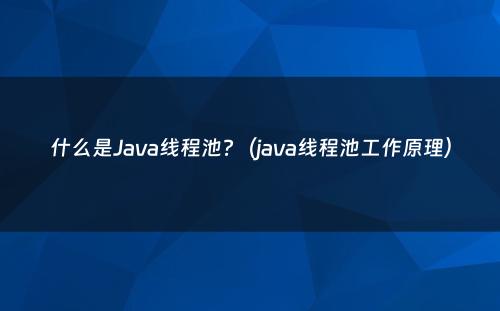网站首页 > java教程 正文
在现代软件开发中,线程池作为并发编程的核心技术,对系统的性能和稳定性有着重要的影响。合理使用线程池可以显著提升系统的响应速度和资源利用率。本文将详细探讨如何创建线程池、为什么推荐使用ThreadPoolExecutor构造函数创建线程池,以及线程池参数的详细解析。

如何创建线程池?
创建线程池有两种常见方式:通过ThreadPoolExecutor构造函数直接创建(推荐)和通过Executors工具类创建。我们将详细介绍这两种方式及其各自的优缺点。
方式一:通过ThreadPoolExecutor构造函数创建(推荐)
通过ThreadPoolExecutor构造函数创建线程池是推荐的方式,因为这种方式能让开发者更加明确地设置线程池的各个参数,避免资源耗尽的风险。
示例代码
java
import java.util.concurrent.BlockingQueue;
import java.util.concurrent.LinkedBlockingQueue;
import java.util.concurrent.ThreadPoolExecutor;
import java.util.concurrent.TimeUnit;
public class CustomThreadPoolExample {
public static void main(String[] args) {
BlockingQueue<Runnable> workQueue = new LinkedBlockingQueue<>(10);
ThreadPoolExecutor executor = new ThreadPoolExecutor(
5, // corePoolSize
10, // maximumPoolSize
60L, // keepAliveTime
TimeUnit.SECONDS, // unit
workQueue, // workQueue
new ThreadPoolExecutor.AbortPolicy() // handler
);
for (int i = 0; i < 20; i++) {
executor.execute(new Task());
}
executor.shutdown();
}
}
class Task implements Runnable {
@Override
public void run() {
System.out.println(Thread.currentThread().getName() + " is executing task.");
}
}在这个例子中,我们创建了一个自定义的线程池,设置了核心线程数、最大线程数、空闲线程存活时间等参数,并提交了20个任务给线程池执行。
方式二:通过Executors工具类创建
Executors工具类提供了一些便捷的方法来创建多种类型的线程池,包括:
- FixedThreadPool
- SingleThreadExecutor
- CachedThreadPool
- ScheduledThreadPool
示例代码
java
import java.util.concurrent.ExecutorService;
import java.util.concurrent.Executors;
public class ExecutorsExample {
public static void main(String[] args) {
ExecutorService fixedThreadPool = Executors.newFixedThreadPool(3);
ExecutorService singleThreadExecutor = Executors.newSingleThreadExecutor();
ExecutorService cachedThreadPool = Executors.newCachedThreadPool();
ExecutorService scheduledThreadPool = Executors.newScheduledThreadPool(3);
for (int i = 0; i < 10; i++) {
fixedThreadPool.execute(new Task());
singleThreadExecutor.execute(new Task());
cachedThreadPool.execute(new Task());
scheduledThreadPool.execute(new Task());
}
fixedThreadPool.shutdown();
singleThreadExecutor.shutdown();
cachedThreadPool.shutdown();
scheduledThreadPool.shutdown();
}
}
class Task implements Runnable {
@Override
public void run() {
System.out.println(Thread.currentThread().getName() + " is executing task.");
}
}为什么不推荐使用内置线程池?
在《阿里巴巴 Java 开发手册》中,明确指出线程资源必须通过线程池提供,不允许在应用中自行显式创建线程。同时,也不建议使用Executors工具类提供的默认线程池,因为其默认实现可能带来以下问题:
- FixedThreadPool 和 SingleThreadExecutor:使用无界的LinkedBlockingQueue,可能堆积大量任务,从而导致内存溢出(OOM)。
- CachedThreadPool:使用同步队列SynchronousQueue,允许创建的线程数量为Integer.MAX_VALUE,可能导致创建大量线程,从而导致内存溢出(OOM)。
- ScheduledThreadPool 和 SingleThreadScheduledExecutor:使用无界的延迟阻塞队列DelayedWorkQueue,可能堆积大量任务,从而导致内存溢出(OOM)。
以下是Executors工具类创建线程池的方法源码:
java
// 无界队列 LinkedBlockingQueue
public static ExecutorService newFixedThreadPool(int nThreads) {
return new ThreadPoolExecutor(nThreads, nThreads, 0L, TimeUnit.MILLISECONDS, new LinkedBlockingQueue<Runnable>());
}
// 无界队列 LinkedBlockingQueue
public static ExecutorService newSingleThreadExecutor() {
return new FinalizableDelegatedExecutorService(new ThreadPoolExecutor(1, 1, 0L, TimeUnit.MILLISECONDS, new LinkedBlockingQueue<Runnable>()));
}
// 同步队列 SynchronousQueue,没有容量,最大线程数是 Integer.MAX_VALUE
public static ExecutorService newCachedThreadPool() {
return new ThreadPoolExecutor(0, Integer.MAX_VALUE, 60L, TimeUnit.SECONDS, new SynchronousQueue<Runnable>());
}
// DelayedWorkQueue(延迟阻塞队列)
public static ScheduledExecutorService newScheduledThreadPool(int corePoolSize) {
return new ScheduledThreadPoolExecutor(corePoolSize);
}
public ScheduledThreadPoolExecutor(int corePoolSize) {
super(corePoolSize, Integer.MAX_VALUE, 0, NANOSECONDS, new DelayedWorkQueue());
}线程池常见参数详解
通过ThreadPoolExecutor构造函数创建线程池时,需要设置以下几个重要参数:
java
public ThreadPoolExecutor(int corePoolSize, // 线程池的核心线程数量
int maximumPoolSize, // 线程池的最大线程数
long keepAliveTime, // 当线程数大于核心线程数时,多余的空闲线程存活的最长时间
TimeUnit unit, // 时间单位
BlockingQueue<Runnable> workQueue, // 任务队列,用来储存等待执行任务的队列
ThreadFactory threadFactory, // 线程工厂,用来创建线程,一般默认即可
RejectedExecutionHandler handler // 拒绝策略,当提交的任务过多而不能及时处理时,我们可以定制策略来处理任务
) {
if (corePoolSize < 0 || maximumPoolSize <= 0 || maximumPoolSize < corePoolSize || keepAliveTime < 0)
throw new IllegalArgumentException();
if (workQueue == null || threadFactory == null || handler == null)
throw new NullPointerException();
this.corePoolSize = corePoolSize;
this.maximumPoolSize = maximumPoolSize;
this.keepAliveTime = unit.toNanos(keepAliveTime);
this.workQueue = workQueue;
this.threadFactory = threadFactory;
this.handler = handler;
}关键参数解析
- corePoolSize:核心线程数,线程池中始终保持的最小线程数量。
- maximumPoolSize:最大线程数,线程池中允许的最大线程数量。
- keepAliveTime:当线程数大于核心线程数时,多余的空闲线程的存活时间。
- unit:存活时间的时间单位。
- workQueue:任务队列,用于保存等待执行的任务。
- threadFactory:线程工厂,用于创建新线程。
- handler:拒绝策略,当任务过多且线程池无法处理时,采用的处理策略。
总结
通过合理配置线程池的参数,可以有效管理系统资源,提高任务处理的效率和系统的稳定性。尽量避免使用Executors工具类提供的默认线程池,推荐使用ThreadPoolExecutor构造函数来创建线程池,以便更好地控制线程池的各个参数,从而规避潜在的资源耗尽风险。
使用线程池在大型项目中尤为重要,从Web服务器的请求处理到后台任务的并发执行,线程池的合理配置和使用可以显著提升系统的性能和稳定性。希望本文能帮助你更好地理解和使用Java线程池,提高你的并发编程水平。
?
猜你喜欢
- 2024-09-16 java-线程池详解(java线程池入门)
- 2024-09-16 线程进阶:实战应用之Java线程池全面解析
- 2024-09-16 Java开发之高并发必备篇(七)——线程池
- 2024-09-16 Java-线程池专题(什么是线程池,如何使用,为什么要用)
- 2024-09-16 Java线程之Executors线程池的原理和使用
- 2024-09-16 Java的四种线程池的使用,以及自定义线程工厂
- 2024-09-16 探索JAVA并发 - 线程池详解(java多线程并发编程 线程池)
- 2024-09-16 Java线程池的概念及使用(java 线程池原理详解)
- 2024-09-16 Java线程池核心(十一):线程池状态
- 2024-09-16 Java 线程池(java线程池原理)
欢迎 你 发表评论:
- 12-02u盘在电脑上读不出来是什么原因
- 12-02家庭路由器哪种比较好用(家庭路由器哪种比较好用2020年)
- 12-02怎样装电脑台式机(如何组装电脑台式机)
- 12-02u盘格式化后识别不出来怎么办
- 12-02win7系统怎么调节电脑屏幕亮度
- 12-02iphone14桌面下载(ios14下载桌面)
- 12-02硬盘恢复数据多少钱(硬盘恢复数据要多少钱)
- 12-02win7电脑恢复出厂(win7电脑恢复出厂设置怎么操作的)
- 最近发表
- 标签列表
-
- java反编译工具 (77)
- java反射 (57)
- java接口 (61)
- java随机数 (63)
- java7下载 (59)
- java数据结构 (61)
- java 三目运算符 (65)
- java对象转map (63)
- Java继承 (69)
- java字符串替换 (60)
- 快速排序java (59)
- java并发编程 (58)
- java api文档 (60)
- centos安装java (57)
- java调用webservice接口 (61)
- java深拷贝 (61)
- 工厂模式java (59)
- java代理模式 (59)
- java.lang (57)
- java连接mysql数据库 (67)
- java重载 (68)
- java 循环语句 (66)
- java反序列化 (58)
- java时间函数 (60)
- java是值传递还是引用传递 (62)

本文暂时没有评论,来添加一个吧(●'◡'●)